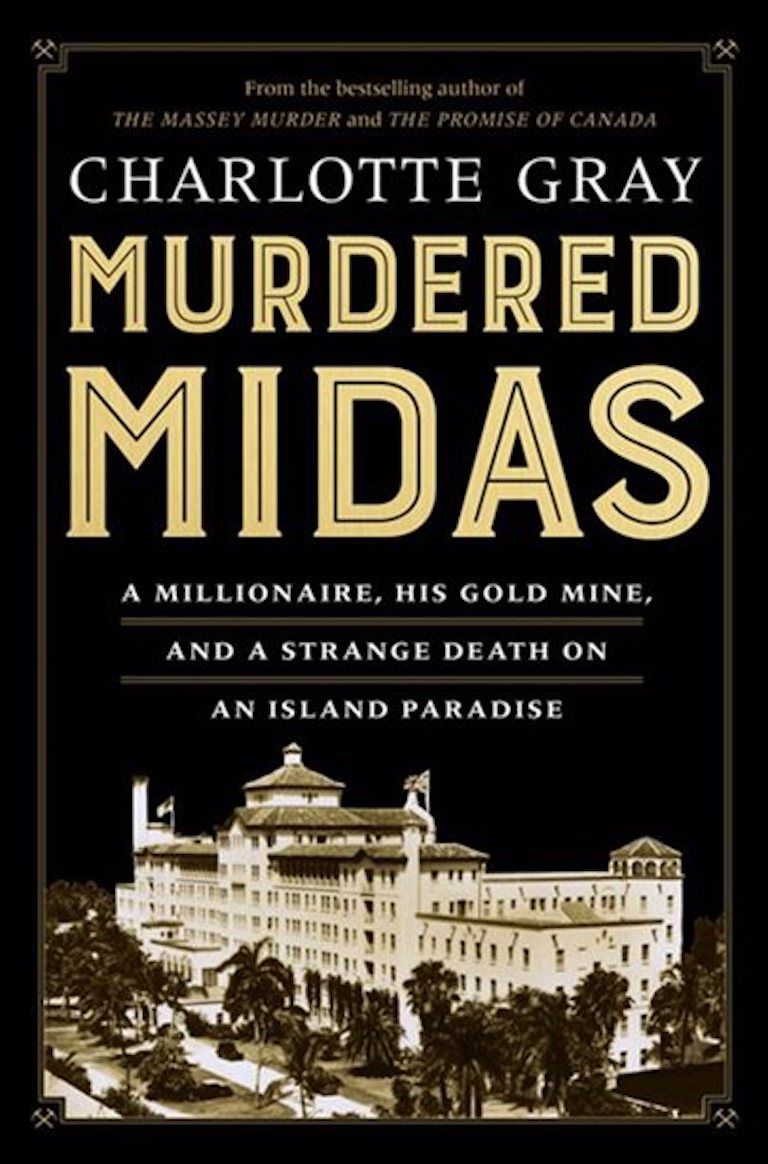Murdered Midas

Murdered Midas: A Millionaire, His Gold Mine, and a Strange Death on an Island Paradise
by Charlotte Gray
HarperCollins Canada,
363 pages, $33.99
A double review with
The Missing Millionaire: The True Story of Ambrose Small and the City Obsessed with Finding Him
by Katie Daubs
McClelland & Stewart,
368 pages, $34.95
Was it Colonel Mustard in the drawing room with a candlestick? Or perhaps Miss Scarlet in the library with a lead pipe? Real-life murder and intrigue are not games, but I know that I’m not the only reader drawn by the thrill of a classic whodunit.
Two recent books — The Missing Millionaire by first-time author Katie Daubs and Murdered Midas by established biographer Charlotte Gray — untangle stranger-than-fiction mysteries from our past.
In many ways, the protagonists of these stories are quite similar. Daubs introduces readers to Ambrose Small, a theatre magnate who built up a small empire in southwestern Ontario and seemingly disappeared into thin air in 1919 after a million-dollar pay-day.
Gray delves into the life of Sir Harry Oakes, a real-life Midas who accumulated ostentatious wealth after striking gold in Kirkland Lake, a northern Ontario mining town. In 1943, he was found bludgeoned and burned to death, coming to a gruesome end in the bed of his Bahamas home.
Two staggeringly wealthy white men, both known for their curmudgeonly, vindictive ways — one dead, one disappeared. It leads to an uncomfortable question: Why should I, a modern reader, care about the fate of these seemingly morally bankrupt members of the wealthy one per cent?
Gray tackles this reality right out of the gate, recalling the words of French writer and philosopher Jean-Paul Sartre: “A corpse is open to all comers.” She sets out to reveal Oakes’s complexities, good and bad, by telling his life story in detail. While Gray does not by any means present an apologist history, she reminds readers that a dead man cannot defend his own reputation. It takes her a while to get to the scandal of his death and its aftermath, but, for a reader who can appreciate context, the payoff is more than worth it.
Daubs takes a slightly different approach. Ambrose Small comes across as an up-from-the-bootstraps entrepreneur — smart, perhaps, but more wily and petty. He was a man who indulged in creature comforts and wouldn’t hesitate to take down an enemy, whether for a perceived slight or to further his own ambitions. I had little sympathy for Small, but Daubs convinced me to care. That’s the mark of a good storyteller.
Gray writes with the ease and narrative style of a seasoned professional, but newcomer Daubs, who is also a reporter for the Toronto Star, holds her own. The Missing Millionaire creates a portrait of 1920s Toronto with such flair and whimsy that you feel yourself instantly transported. As the mystery deepens with time, the city comes of age — a narrative hidden in plain sight adds a rich vibrancy to the book.
Gray’s Murdered Midas has the advantage of a sensational murder and its grim details, which she uses to grab readers’ interest from the first sentence. Where her writing shines, however, is in her ability to maintain that momentum until the drama explodes in its third act — the murder and its investigation.
These books come alive thanks to their casts of characters, which are paraded across the page like in a good game of Clue. The main actors’ motives and machinations are revealed in dramatic fashion.
Daubs introduces us to the likes of Theresa Small, the almost-too-devout wife who makes a show of seeking justice; Jack Doughty, the beleaguered and suspicious secretary; Clara Smith, the lovelorn mistress; and ex-lawman Patrick Sullivan, who courts chaos and entangles himself with the slighted Small sisters. They almost seem too good to be real. But that’s the best part about true crime — it’s true.
Gray has an equally flamboyant set of players and suspects, but one stands above the rest for his notoriety. The Duke of Windsor (Edward VIII, who abdicated in 1936 for his love of the American divorcee Wallis Simpson) was the governor of Bahamas when Oakes met his untimely demise.
The men were an unlikely pair, thrown together by circumstance and the isolating nature of their immense fortunes — the duke banished from the sphere of influence after he had spurned the throne, and Oakes seeking a tax haven to guard his riches. There were whispers of shady business dealings between the two men, but the real drama began at Oakes’s end. The duke played an oversized role in the ensuing investigation, and Gray does not shy away from casting doubt on his intentions.
Murder and scandal weave a tangled web, and no one escapes the microscope of these writers. Questions abound, but answers are harder to find. If you’re hoping to find a murderer unmasked or a disappearance resolved, these are not the books for you. Gray and Daubs may have their theories, but they are smart enough not to show their hand, instead inviting readers to sleuth alongside them.
Who killed Sir Harry Oakes? Where in the world is Ambrose Small? We may never know, but, in The Missing Millionaire and Murdered Midas, the journeys are so entertaining that it makes it hard to care.
Themes associated with this article
Advertisement




